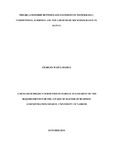| dc.description.abstract | Micro insurance has become popular because the poor face lots of risks that they have no
control over, and have a huge impact on their lives. For instance, farmers are highly
susceptible to rainfall variances if the rain falls too hard, too soon or too late, an entire
harvest can be wiped out. The study’s objective is to determine the effects of advancement in
technology, competition and subsidies on the growth of Micro insurance in Kenya. This is a
strange phenomenon because people were previously uninsurable because of poverty and the
high risk involved. The method is not restricted to fact finding, but may often result in
formulation of important principles of knowledge and solutions to problems. It is also able to
give a detailed description of how one variable explains another or one variable is explained
by another variable. This study used secondary data for the various variables that was put to
the model. The secondary data was obtained from insurance firms, Communications
Commission of Kenya, Insurance Regulatory Authority and Safaricom. To ensure that the
data collected is valid and reliable, the researcher used data from established sources. The
researcher will also consult extensively with practitioners and experts in the specific fields
before the data is adopted. Data analysis is the process of bringing order, structure and
meaning to the mass of information collected. It involves examining what has been collected
and making deductions and inferences. The research message method to be adopted in this
paper was the quantitative method since the research is more concerned with the impact
between variables and analysis of the causal using numerical data and statistics. Comparison
on growth of micro insurance before and after development in technology, increased
competition and subsidies was carried out to establish significant differences. The technique
to be used is linear regression analysis using SPSS. The study shall have one dependent
variable and three independent variables. The dependent variable was growth in micro
insurance while the independent variables are technology, competition and government
subsidies. To measure advancement in technology, the researcher used the access to mobile
telephone. The researcher used the number of registered subscribers over the period,
registered M-Pesa users and compares it with the number of clients under micro insurance.
Competition was determined by the number of firms which was offering micro insurance
products while subsidies were measured by the amount of financial incentives provided by
the government. Growth in micro insurance was measured using the number of firms offering
micro insurance products and the amount of premiums collected per annum over the period
under review. The study findings established that the first hypothesis stated that Competition
in the micro insurance industry had a negative impact on the growth of micro insurances as
well as their profitability. The study’s established a negative coefficient between competition
and growth in micro insurances (p = 0.322) points at acceptance of the null hypothesis of
insignificant relationship. This depicts that increase in the level of competition in the micro
insurance industry negatively influences their financial performance. The study established a
significant positive coefficient (p = .501) between Technological advancement in the micro
insurance industry and the growth in Micro insurance. Thus, the null hypothesis is rejected
and alternative hypothesis of significant relationship accepted. This depicts that changes in
technological advancement is directly proportional to the growth in microinsurace industry.
The third hypothesis tested the relationship between Subsidies and growth in micro
insurances. It stated that Offers of subsidies has significant increase on the growth of micro
insurances. The study established a positive coefficient significant at α=5%. Thus, the null
hypothesis is accepted. This implies that Micro insurances that are given subsidies that realize
more growth and earn more profit. | en_US |

